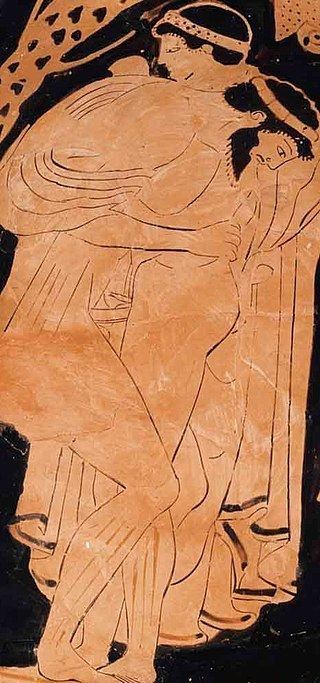 Similar Mammary intercourse, Conventional sex, Doggy style | ||
Intercrural sex (from inter- and Latin crura, "legs"), also known as femoral/interfemoral sex/intercourse, is a type of non-penetrative sex, in which a male places the penis between the receiving partner's thighs (often with lubrication), and thrusts to create friction.
Contents
Heterosexuality
The sex education and sexual experimentation of adolescents may feature intercrural sex in the interests of avoiding pregnancy or preserving virginity. Shere Hite's 1976 and 1981 research on female sexuality found that some adult women reported being able to achieve orgasm via intercrural contact to stimulate the clitoris. A variation of heterosexual intercrural sex is a practice known in Japan as sumata. In Zulu it is referred to as okusoma. It has a long history as an accepted practice for young people in Southern Africa.
Male homosexuality
Intercrural intercourse was a common outlet for pederasty in ancient Greece, because anal sex was considered demeaning to the receiving partner. The Ancient Greek term for this practice was διαμηρίζειν diamērizein ("to do [something] between the thighs").
The historian Kenneth Dover wrote about this extensively in his book Greek Homosexuality (1978), whence current theories on the subject of sex between men in Ancient Greece derive. Joan Roughgarden refers to standing, face-to-face intercrural intercourse as the "gay male missionary position" of Ancient Greece in a section of her book Evolution's Rainbow (2004), which draws heavily on Dover.
Intercrural sex among men who have sex with men (MSM) is sometimes known as the "Princeton First-Year", the "Oxford Style", the "Oxford rub", or the "Ivy League rub", and is a form of same-gender frottage, or colloquially "frot". The synonyms that refer to schools describe activities of "horny young men during the long, cold winters, away at all-boys schools", especially in the 19th century.
Intercrural sex has been proposed as an important part of the sexual lives of a handful of notable historical figures known or thought to have been homosexual or bisexual. According to his biographer Richard Ellmann, Oscar Wilde was introduced to intercrural sex by Robert Baldwin Ross, and it appears to have been his preferred activity, even over oral sex. Shaka Zulu is speculated to have encouraged intercrural sex among his troops to "create intimacy and loyalty." Quotes attributed to the Cynic philosophers regarding Alexander the Great, made both during and after his lifetime, seem to presume intercrural sex between Alexander and Hephaestion. Similarly, comments made by a bed mate about Abraham Lincoln's thighs led to speculation of intercrural sex between the two in C. A. Tripp's recent The Intimate World of Abraham Lincoln.
It has been subject to various historical sodomy laws and religious restrictions enacted mostly by Christianity. Intercrural sex appears to have been common during the medieval era; for example, a contemporary document titled the "Altercatio Ganimedis et Helene" (The Debate of Helen and Ganymede) depicts Greco-Roman mythical figure Ganymede describing the "slippery thighs of a boy" as superior to the "stink and gaping looseness of the female cave."
A 1997 report on the sexual health needs of males who have sex with males in the Calcutta suburbs found that 73% of men asked engaged in intercrural sex, though the frequency varied based on demographic factors: only 54% of sex workers, 50% of lower income men and 40% of Muslims reported intercrural sex; while 82% of Hindus and 88% of middle income men reported engaging in it.
